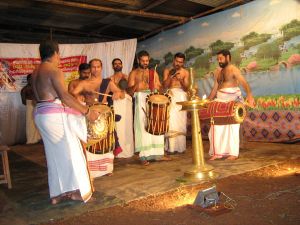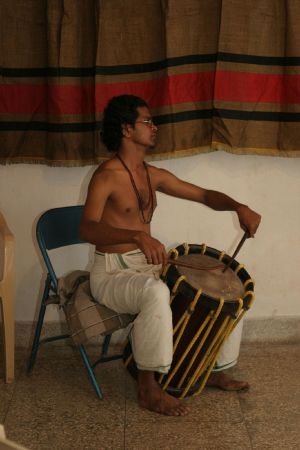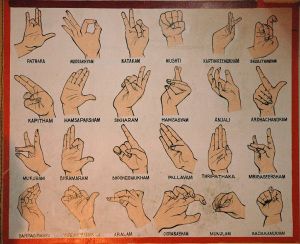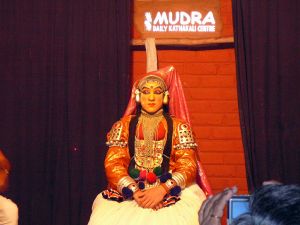Kathakali
Kathakali (ŗīēŗī•ŗīēŗī≥ŗīŅ, pronounced [katŐ™ į…ôka…≠i]), a form of ritual dance drama, originated in the Southern Indian state of Kerala during the late sixteenth century. Evolving from earlier forms of dance drama such as Koodiyattam, Ashtapadiyattom, Krishnattam and Ramanattom, it was performed in palaces and temples and at religious festivals. Kathakali draws its subject matter from the Hindu epics chronicling the lives, loves and conflicts of the gods and heroes of Indian mythology.
Sacred Indian dance drama, such as Krishnattom and Ramanattom, emerged as part of Vaishnavism, when cultural influences were eroding the adherence of the people to Hindu traditions. Watching a dramatization of Krishna’s story was meant to evoke an emotional attachment to Krishna, and bring about the devotion to Krishna that assured salvation. The motivation and purpose of drama traditions such as Kathakali are very different from those of modern Western theater, which is usually intended either to stimulate reflection on moral issues, or simply to entertain an audience and evoke sentiments such as nostalgia and romance. Dance drama like Kathakali can be compared to ancient Greek theater, which was intended to bring about reflection on human nature and inspire higher thought in its audiences. Buddhist drama, such as that which developed in China and Japan, also attempted to engage the audience in self-reflection, in order to bring about a deeper understanding of the truth.
A traditional Kathakali performance usually lasts all night, but modern performances are often shortened to two to four hours. Accompanied by percussion instruments, two vocalists sing the words of a dialogue, while silent actors vividly translate their words into a language of facial expressions, bodily attitudes and poses, and figurations of the hands (mudras). Kathakali performers with their heavy, stylized makeup, complemented by elaborate costumes and opulent head dresses, make a striking psychological impression on the viewer. The combination of costume, ornaments and makeup colors identifies each character as one of five dramatic types.
History
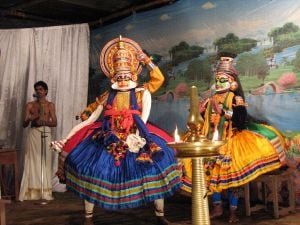
Kathakali has its origins almost 1500 years ago in the early ritual folk dances and dance dramas of Kerala, in southern India, such as the dances associated with the cult of Bhagavathy (Thiyyattom, Mudiyettu, and Theyyam), that were performed at religious festivals by actors wearing elaborate masks, colorful costumes and headdresses, and intricately painted faces;[1] and socio-religious and material dances such as the Sastrakali and Ezhamattukali. Ashtapadiyattom, a dance drama based on the Gita Govinda of the twelfth-century poet Jayadeva, told the story of Krishna embodied as a humble cowherd, his consort Radha, and three cow girls. In 1655, Manavedan, the Zamorin Raja of Calicut, wrote Krishnagiti, a dance drama to be performed as Krishnattom (Krishnan; attom (enactment)) on eight consecutive nights, incorporating elements of Ashtapadiyattom and Koodiyattam, another form of Sanskrit ritual dance drama. The performance of Krishnattam was strictly restricted to the Guruvayur Temple, palaces of the members of the Zamorin's family, and temples and houses of Namboodiri Brahmins within the jurisdiction of the Zamorin's empire.[2] Krishnattam told the story of Krishna, using dance and mime, while the narrative was sung by musicians.
According to legend, Kottarakara Thampuran, the Raja of Kottarakara (once a province of Kerala), a great admirer and promoter of traditional art forms, invited the Zamorin to present Krishnattom in Kottarakkara. The Zamorin refused, saying that Krishnattom was not for the unsophisticated audience of southern Kerala. In response, Kottarakara Thampuran composed several plays and created Ramanattom (Raman; attom(enactment)), also performed on eight consecutive nights. At first, Ramanattom enacted stories from Ramayana and other epics, but as it evolved into Kathakali, it began to encompass many stories.[3]
Kathakali shared similarities with both Ramanattom and Krishnanattom, but incorporated several outside elements from the folk and martial arts of Kerala which contributed to its popularity.[3] The increasing use of the local language, Malayalam (as a mixture of Sanskrit and Malayalam, called Manipravaalam) made it more popular among the masses, who could not understand the ancient Sanskrit language. In time, masks were discarded in favor of more elaborate facial make up.[4]
Around the seventeenth century, acting became separated from singing, leaving the actors free to concentrate on dramatic expression. Towards the end of the seventeenth century, Prince Kottayam wrote four plays based on the Mahabharata, liberating Kathakali from adherence to any particular Hindu epic and distinguishing it from Ramanattom. Emotion expressed in the face became central to performances, and he introduced a white frame around the face, and red features on a green background, to emphasize movements of the facial features.
In the eighteenth century, Kapplingattu Nampoothiri (b. 1740) introduced a number of innovations that shaped Kathakali as it is performed today. He improved the percussion accompaniment, and standardized the use of alarrca, the inarticulate cries made by demons and animals. He further borrowed mudras from Koodiyattam, and harmonized their use with body movements. He clarified and defined the five types of character and strengthened the use of three-dimensional makeup. He also developed the ‚Äúkathi,‚ÄĚ (knife) character type, which combined noble features with evil qualities, as the central role in Kathakali plays.[5]
Kathakali was traditionally performed during religious festivals. Several Hindu ethnic groups participated in the performance of Kathakali. In its early days, the Nair community dominated because they were often well-versed in the martial art, Kalarippayattu, which is used in Kathakali training and, in a mild form, on the stage.
Kathakali, as it is performed today, is just more than four centuries old. It is no longer restricted to temples, palaces and religious festivals, but is often presented in theaters and at special events as entertainment, and is performed far more frequently than the older forms of dance drama to which it is related.[6]
Etymology
The name ‚ÄúKathakali‚ÄĚ derives from the Malayalam words "katha" (story) and "kali" (play). A text written to be produced as a Kathakali is referred to as "Aattakkatha."
Elements of fine art
Kathakali is considered to be a combination of five elements of fine art:
- Natyam (Acting), the use of facial expressions to convey emotion
- Nrithyam, the use of hand gestures "mudras,‚ÄĚ to convey meaning and emotion
- Nritham (Dance), the use of rhythm and movement of hands, legs and body
- Sangeetham (Music): Song/Vocal accompaniment (Geetha), and instrumental accompaniment (Vadyam)
- Chutti: Painting or make up
The lyrics, which qualify as literature (Sahithyam), are considered a component of Geetha, and play a supplementary role to Nritham, Nrithyam and Natyam. Kathakali songs, couched in rich poetic diction, are among the gems of Malayalam literature.[7]
Kathakali plays
There are 101 classical Kathakali stories, most of which were initially composed to last a whole night. Modern performances are often shortened to two to four hours by selecting the most dramatic or popular portions of individual stories. For its themes, Kathakali draws upon the inexhaustible lore of the ancient puranas chronicling the lives, loves and conflicts of the gods and heroes of Indian mythology. The most popular stories enacted are Nala Charitam (a story from the Mahabharata), Duryodhana Vadham (a story from the Mahabharata), Kalyanasowgandhikam (the story of Bhima going to get flowers for Panchali, from the Mahabharata), Keechaka Vadham (another story of Bhima and Panchali, from the Mahabharata), Kiratham (Arjuna and Lord Shiva's fight, from the Mahabharata), and Karna Shapadham (another story from Mahabharata). Recently, as part of an attempt to popularize the art, stories from other cultures, such as the story of Mary Magdalene from the Bible, Homer's Iliad, and Shakespeare's King Lear have also been adapted into Kathakali scripts.
Kathakali is a classical art form that can be appreciated by both novices and connoisseurs, because of its frequent use of ‚Äúlokadharmi‚ÄĚ (the elaboration of folk elements) with which novices are already familiar. ‚ÄúNatyadharmi‚ÄĚ (the science of acting elaborated in the classic acting manual, the Natyashastra) is better understood by connoisseurs. A spectator who already knows something about the story being enacted will be better able to appreciate the ‚Äúpersonalization‚ÄĚ of characters by individual actors. One of the major enjoyments for traditional Kathakali connoisseurs is distinguishing and discussing the "personalizations" that each actor brings to his depiction of the story. The success or failure of amateur Kathakali artists is often determined by their ability to successfully personalize characters.
Music
Music is an essential element of Kathakali. The language of the songs used for Kathakali is Manipravalam, a blend of Sanskrit with the local language, Malayalam. Even though the songs are set for ‚Äúragas‚ÄĚ based on Carnatic music, there is a distinct style of rendition, known as the ‚Äúsopanam‚ÄĚ style, incorporating the moods of temple songs that were sung at the time when Kathakali was evolving. Sopanam has a very slow tempo and is free of embellishments, giving the actors complete freedom to exercise their art of expression.[7]
A Kathakali orchestra is composed of a lead vocalist (‚Äúponnani‚ÄĚ) keeping time with a resounding gong made of bell metal (chegala), which can be struck with a wooden stick; and a minor vocalist (‚Äúsingidi‚ÄĚ) with a pair of clanking cymbals (elethalam); a chenda (cylindrical drum with a loud but sweet sound) player and maddalam player. Sometimes a percussion instrument known as an edakka is also used.
Performance
A traditional Kathakali performance is usually conducted at night and ends early in the morning. Kathakali is usually performed in front of a kalivilakku (‚Äúkali‚ÄĚ= dance; ‚Äúvilakku‚ÄĚ= lamp), which provided light when the plays were performed inside temples, residences of nobles, and palaces. A Kathakali performance scheduled to begin at 10:00 pm will be announced in a special manner by the loud playing of chenda, maddalam (percussion), elathalam and chengila (metallic cymbals) during the evening, so that they can be heard even at a distance. This instrumental music, called kelikottu, is very familiar to lovers of Kathakali.
Accompanied by the chenda, maddalam, chengala and elethalam, the vocalists sing the words of a dialog from behind the silent actors, who vividly translate their words into a language of facial expressions, bodily attitudes and poses, and figurations of the hands. Mudras (hand gestures) are used as a substitute for spoken language. As the songs proceed, the actors, moving in time to the music, recreate the epic and bring the words to life. Each character’s every emotion is expressed on the face with an intense, stylized vividness, in harmony with the rhythm of the dance and melody of the music. The actors not only express the subjective emotions of the human heart, but give objective impersonations of the characters, scenes, creatures and surroundings.
Acting
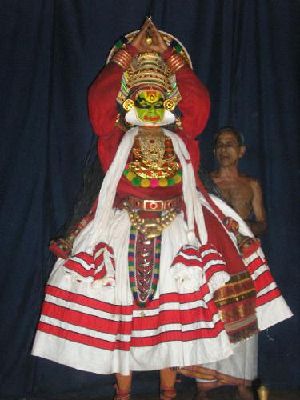
A Kathakali actor needs immense powers of concentration, skill, and physical stamina, gained through training based on Kalaripayattu, the ancient martial art of Kerala. Training begins around the age of ten, and often lasts for eight to ten years. The training program is intensive; each day begins at 3:30 am and ends at 8:30 pm, with short breaks in between. During the monsoon and winter there are rigorous body massage sessions. Each student learns the complete language of Kathakali, memorizing the combinations of facial expressions (rasas), bodily movements and hand gestures (mudras). Dancers also undergo special practice sessions to learn control of their eye movements.
There are 24 main mudras and numerous lesser mudras. Each mudra can be classified into samaana-mudras (one mudra symbolizing two entities) or misra-mudras (mudras requiring the use of both the hands). The mudras are a form of sign language used to tell the story.
As in other forms of Indian dance drama, a Kathakali artist uses nine main facial expressions (navarasams, anglicized as navarasas; literal translation: ‚Äúnine tastes,‚ÄĚ but more loosely translated as ‚Äúnine feelings or expressions‚ÄĚ): Sringaaram (love), Haasyam (ridicule, humor), Bhayam (fear), Karunam (pathos), Rowdram (anger, wrath), Veeram (valor), Beebhatsam (disgust), Adbhutham (wonder, amazement), and Saantham (tranquility, peace).
Make-up and costumes
A Kathakali artist, Mattbaier, putting on facial colors in Kochi, Kerala.
As in the other forms of ritual dance drama, costumes, ornaments and facial makeup together constitute a character type. There are five main types of characters, usually identified by the predominant color of makeup applied to the face or its pattern: pacha (green), kathi (knife), thadi (beard), kari (black) and minukku (polished). Green is the predominant color of pacha, virtuous and noble male characters with a pious and kingly nature. Kathi, proud, aggressive and unrighteous characters such as the demon king Ravana, are portrayed with red as the predominant color in a green background. There are three varieties of the bearded type, thadi. The most aggressive and demonic, known as chuvanna thadi (red beard), wear predominantly red makeup and a red beard. Mythical and fabulous beings like Hanuman (the monkey god) are known as vellathadi (white beard); aboriginals, forest-men and cave-dwellers are known as karutha thadi (black beard). The lowest and most aggressive beings are kari (black) and have small patterns of red, white and yellow on a completely black face. Gentle and spiritually inclined characters, such as noble women, sages, ascetics and Brahmins, have lustrous, yellowish faces and are known as minukku (polished).
The makeup is made from various mineral ores and pigments, ground on a stone and mixed with coconut oil before being applied on the face. Application of the elaborate facial makeup requires hours of labor by the actors and a trained chuttikkaran, who applies fine lines of rice paste and affixes bits of white paper as prescribed for each type of character. Some characters also have enhanced features, such as enlarged noses or elaborate mustaches, made using elaborately cut paper which is stuck to the face with a mixture of rice paste and calcium carbonate. Dancers often turn the whites of their eyes red by placing a "chundanga seed" (from a variety of eggplant which bears small fruits) under their lower eyelids before the performance. The chundanga is prepared by removing the ovaries at the base of the flowers of this plant, and rubbing them in the palm of the hand until they turn from white to black.
Elaborate costumes and ornamentation are designed to heighten the superman effect. By the time an actor has assumed his complete costume and makeup, he resembles a sculpture. Large overcoats, flowing scarves, bulging skirts, antique ornaments, opulent head dresses with streaming hair flowing down to the waist and covering the back, complement the elaborate makeup to create enlarged figures that make a striking psychological impression on the viewer.
Popularity
Like other Hindu forms of dance drama, such as Koodiyattam, Kathakali evolved as a ritual dance, to be performed as an offering at temples and during religious festivals. While the other forms remained relatively unknown, Kathakali reached a broad audience and achieved that status of a widely-recognized national treasure. Several factors have contributed to its popularity. The performance of Kathakali was not restricted to sacred temple grounds or palaces, making it accessible to ordinary people. Kathakali was performed in Malayalam, the spoken language of Kerala, and incorporated local folk traditions and a broad range of familiar episodes from the Hindu epics. During the late nineteenth and twentieth centuries, Kathakali also attracted the interest of Western audiences.
Outstanding Kathakali artists such as Kalamandalam Ramankutty Nair (b. 1925, recipient of prestigious Kalidas award), Keezhpadom Kumaran Nair (1913 ‚Äď 2007, recipient of the prestigious Padmashree award) and Kalamandalam Padmanabhan Nair (1928 ‚Äď 2007) not only trained young actors in the Kathakali tradition, but created new choreography and gained international exposure by taking Kathakali performances abroad. Kathakali performances have been documented in several films, including Kalamandalam Ramankutty Nair (2005) and the award-winning Vaanaprastham (1999) directed by Shaji N Karun and acted by Mohanlal.
Training centers for Kathakali
From its inception, Kathakali artists and training schools (kaligoyams) were supported by royal patrons who often contributed artistically. In the late nineteenth and early twentieth centuries, the traditional system of patronage collapsed as royal families lost much of their wealth and status, and as Western cultural influences eroded respect for Indian artistic traditions. In 1922, the poet Vallotol began an initiative to restore Kathakali by introducing ticketed performances and an institutionalized training center, the Kalamandalam.
The most popular Kathakali artists have obtained their training from one the four oldest training centers, which follow the traditional "gurukula" style:
- Kerala Kalamandalam (located in Cheruthuruthy, near Shoranur, Kerala)
- PSV Natya Sanghom (located in Kottakal, near Kozhikode, Kerala)
- Gandhi Seva Sadan Kathakali and Classic Arts Academy (located in Perur, near Palakkad, Kerala)
- Unnayi Varier Smaraka Kalanilayam (located in Iringalakuda, near Thrissur, Kerala)
There also several relatively new centers:
- Vella Kathakali Vidyalayam
- Kalabharathi Kathakali Vidyalayam
- FACT Kathakali School
- RLV Kathakali Vidyalayam
- Margi, located in Tiruvanantapuram
Notes
- ‚ÜĎ V. Ponmelil, More Dance Forms of Kerala, Newkerala.com. Retrieved June 17, 2008.
- ‚ÜĎ On Krishnattam, Geocities.com. Retrieved June 17, 2008.
- ‚ÜĎ 3.0 3.1 Kerala tourism, Arts of Kerala, Keralatourisminfo.biz. Retrieved June 17, 2008.
- ‚ÜĎ Art Kerala, Ramanattom, Art Kerala. Retrieved June 17, 2008.
- ‚ÜĎ John Glynn, Kathakali: A Study of the Aesthetic Processes of Populist Spectators and Elitist Appreciators Engaging with Performances in Kerala, Phd. thesis, University of Sydney, December 2001. Retrieved June 17, 2008.
- ‚ÜĎ Kerala Arts, Kathakali, Kerala Arts. Retrieved June 17, 2008.
- ‚ÜĎ 7.0 7.1 Art Kerala, Kathakali Retrieved June 17, 2008.
ReferencesISBN links support NWE through referral fees
- Banerji, Projesh. Kathak dance through ages. Atlantic Highlands, N.J.: Humanities Press.1983.
- Bharatha Iyer, K. Kathakali; the sacred dance-drama of Malabar. London: Luzac. 1955.
- Jones, Clifford Reis, and Betty True Jones. Kathakali; an introduction to the dance-drama of Kerala. San Francisco: American Society for Eastern Arts. 1970.
- Mansingh, Sonal, and Avinash Pasricha. Classical dances. New Delhi: Wisdom Tree. 2007. ISBN 8183280676
- Menon, Kalpalli Pulapra Sankunni. A dictionary of Kathakali. Bombay: Orient Longman. 1979.
- Singh, Nagendra Kr. The Mahabharata in Kathakali dance drama. New Delhi: Global Vision Pub. House. 2006. ISBN 8182201810 ISBN 9788182201811
- Zarrilli, Phillip B. Kathakali dance-drama: where gods and demons come to play. London: Routledge. 2000. ISBN 041513109X ISBN ISBN 9780415131094 ISBN 041519282X ISBN 9780415192828
External links
All links retrieved March 2, 2025.
| ||||||||
Credits
New World Encyclopedia writers and editors rewrote and completed the Wikipedia article in accordance with New World Encyclopedia standards. This article abides by terms of the Creative Commons CC-by-sa 3.0 License (CC-by-sa), which may be used and disseminated with proper attribution. Credit is due under the terms of this license that can reference both the New World Encyclopedia contributors and the selfless volunteer contributors of the Wikimedia Foundation. To cite this article click here for a list of acceptable citing formats.The history of earlier contributions by wikipedians is accessible to researchers here:
The history of this article since it was imported to New World Encyclopedia:
Note: Some restrictions may apply to use of individual images which are separately licensed.
